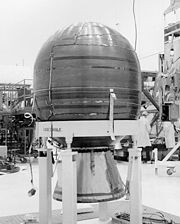Payload Assist Module
The Payload Assist Module (PAM) is a modular upper stage designed and built by McDonnell Douglas (now Boeing), using Thiokol Star-series solid propellant rocket motors. The PAM was used with the Space Shuttle, Delta, and Titan launchers and carried satellites from low Earth orbit to a geostationary transfer orbit or an interplanetary course. The payload was spin stabilized by being mounted on a rotating plate.[1] Originally developed for the Space Shuttle, different versions of the PAM were developed:
- PAM-A (Atlas class), development terminated; originally to be used on both the Atlas and Space Shuttle
- PAM-D (Delta class), uses a Star-48B rocket motor
- PAM-DII (Delta class), uses a Star-63 rocket motor
- PAM-S (Special) as a kick motor for the space probe Ulysses
The PAM-D module, used as the third stage of the Delta II rocket, was the last version in use. As of 2018, no PAM is in active use on any rockets.
2001 re-entry incident[]
On January 12, 2001, a PAM-D module re-entered the atmosphere after a "catastrophic orbital decay".[2] The PAM-D stage, which had been used to launch the GPS satellite 2A-11 in 1993, crashed in the sparsely populated Saudi Arabian desert, where it was positively identified.[2]
Gallery[]

PAM-D stage in assembly

SBS-3 satellite with PAM-D stage being launched from Space Shuttle Columbia

Saudi officials inspect a PAM-D module that re-entered the atmosphere in 2001
References[]
- ^ "Payload Assist Module (PAM)". Global Security. Retrieved June 8, 2012.
- ^ a b "PAM-D Debris Falls in Saudi Arabia" (PDF). The Orbital Debris Quarterly News. NASA Johnson Space Center. 6 (2): 1. April 2001.
External links[]
| Wikimedia Commons has media related to Payload Assist Module. |
- Payload Assist Module at the NASA Shuttle Reference Manual
- Payload Assist Module at GlobalSecurity.org
- Solid-fuel rockets
- Rocket stages






